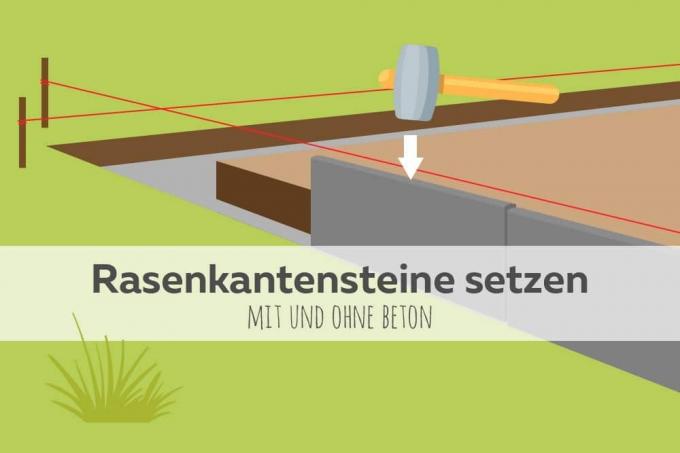
table of contents
- Set lawn edging stones
- Tools and materials
- Set lawn edging stones with concrete
- instructions
- Lay lawn edging stones without concrete
- instructions
The lawn boundary is an important element of garden design. Lawn edging stones prevent the grass from overgrowning and thus allow easy control of the area. With a well-built lawn edging you can without major problems race relocate and separate other plants, paths, terraces or work areas. There are several methods available to you that you can use to set the stones, which work with or without concrete.
Set lawn edging stones
When many gardeners use the term “lawn edging stones”, they immediately think of natural stones that give the garden a rustic look. Depending on the type of stone used, modern or minimalist accents are possible. The following list gives you an overview of the various artificial and natural stones that you can use for this:
- granite
- Gneiss
- Cobblestones
- Concrete blocks
Natural stones such as granite are the ideal solution for many people because they are very resistant and easy to lay. They even endure the cold, and it is not difficult to set them. Some manufacturers offer lawn edging stones made of concrete, which are quite cheap and, due to the manufacturing process, compliant. This allows them to be laid directly next to one another. Mowing edge or L-stones made of this material can also be used, which do not require any concrete foundation. Gneiss stones are among the most expensive variants, but they are very popular in the garden because of their effect. The following dimensions should be taken into account when selecting the stones:
- Height: 25 cm recommended
- Thickness: 5 to 6 cm
When it comes to the height, make sure that it protrudes three to four centimeters from the ground at the end and that the foundation is about four centimeters high at the same time. Precisely for this reason, stones with a height of 25 centimeters are recommended, as 15 centimeter variants only offer limited protection. In addition to the stones, other materials and utensils are important to create a lawn edge yourself. If you want to lay classic paving stones, you have to make sure that the foundation has to be higher. In most cases, these are not offered in lengths of 25 centimeters, unless you choose rectangular plasters.

tip: As an alternative to natural or paving stones, lawn edging can be made from other materials which, due to their own style, are excellent for a wide variety of gardening projects to offer. This includes elements made of wood, metal or plastic, the shape of which can even be modeled on real stones.
Tools and materials
Regardless of whether you want to use the stones as a boundary with or without concrete, the basic equipment is the same. The following list gives you an overview of the necessary tools and materials:
- spade
- Guideline
- Lawn edging stones in the required quantity
- gloves
- Pavement hammer or other hammer
- Spirit level
- Folding rule
Please note: This list does not contain the necessary materials for the respective setting method, but, as already mentioned above, only the Basic equipment for both variants. You should definitely have these available when implementing the project in order to make it much easier for you. Pen and paper are part of the planning of the lawn edge, as you should definitely visualize it before setting it. In this way you can determine how many stones and material you need for the edge and how it runs in the first place.
tip: You can also take a photo of your garden and draw the lawn edge in the finished picture. This means that you can see in advance exactly how it has to work in order to be effective in the garden.
Set lawn edging stones with concrete
The classic setting variant for lawn edges is the use of a Concrete foundationsthat carries the stones, which then act as masonry and thus keep the grass from growing. In order to realize this variant, you will need additional materials:
- Lean concrete
- Concrete mixer
- bucket
- safety goggles
- gloves
- Mortar trowel
If you don't have a concrete mixer yourself or want to buy one, it is a good idea to borrow one. You can find these at hardware stores for a daily rate of around 20 euros.
instructions
1. Dig the trench along the edge of the lawn. The width does not have to correspond directly to the thickness of the stones and can be a little wider.

2. Stretch the plumb line next to the trench at the height you need for the visible delimitation of two to four centimeters. Check again and again with a spirit level and a folding rule that they are correctly positioned.
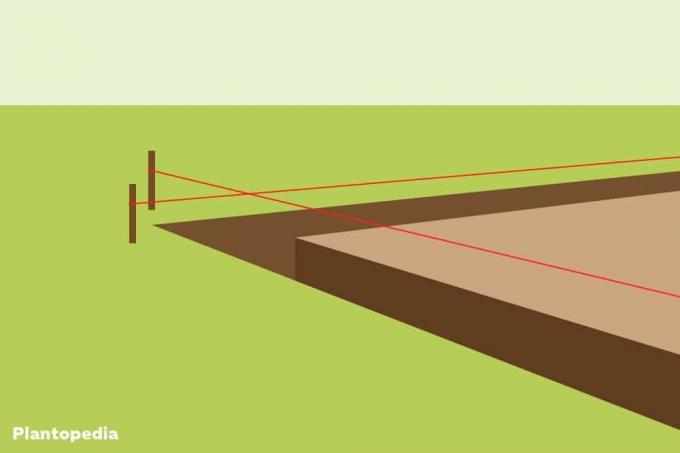
3. Now mix the concrete and then fill it into the pit for the first meter at a height of four centimeters. If you only need to draw a short lawn edge, you can immediately fill the entire foundation into the pit. For longer sections, you should always only put one part at a time.

4. As soon as the concrete is filled, place the stones in the middle of the concrete and hit them with the hammer at the set height. Then check that the stone is straight. Then repeat steps 3 and 4 until the entire lawn edge is complete.

5. In the meantime, check the position of the stones again and again, whether they have shifted in any way. If so, you need to correct this with the mortar trowel. You can also always refill some of the lean concrete if the lawn edging stones do not sit properly or tilt slightly.
6. Finally, you need to let the lean concrete dry. This can take a long time, depending on the length and width of the lawn edge. Then the boundary is in place and you can still seal the joints with mortar, if you wish.
This method is also very suitable for lawn edges made of metal, plastic or wood. Since these are fixed by the mortar, it is easy to set them.
Lay lawn edging stones without concrete
If you do not want to use a concrete foundation, a mixture of sand and gravel is used. This "loose" foundation is compacted and enables the stones to function as lawn edging without having to use wet materials. In addition to the utensils mentioned above, you will also need the following:
- Construction sand or gravel
- Hand tamper
Since lawn edges are not very wide, you cannot use a plate compactor and have to switch to a hand rammer to compact the foundation.
instructions
1. The course of the lawn edges is marked out as when setting in concrete and then the earth is dug with a spade. The depth of the trench for the stones should correspond to the length of the spade blade so that they sit well and cannot shift too much. The width of the pit, on the other hand, must correspond to the thickness of the stones.
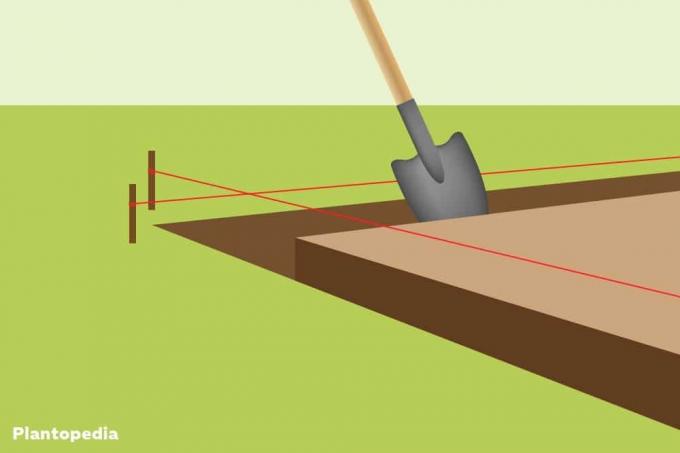
2. Now fill the trench with a four-inch layer of sand or gravel. You can also fill in three centimeters of gravel and one centimeter of sand and compact them together. In many cases this is even more effective than just a sediment.
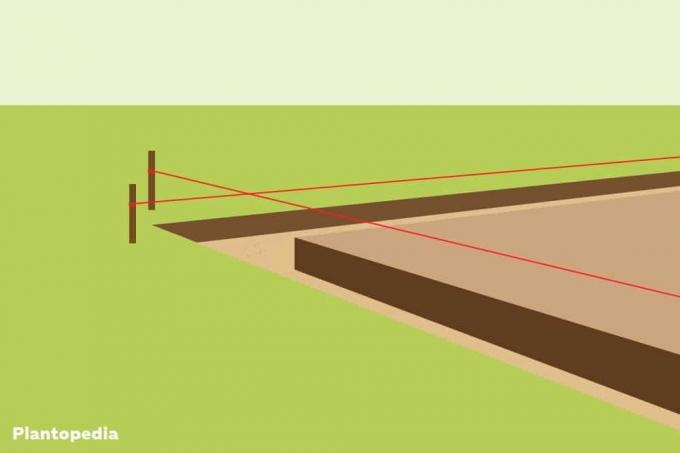
3. Use the hand tamper to compact and tamp the foundation with it. If you are not strong enough yourself, you should ask a helping hand to do this step for you. This task can be very strenuous and requires a lot of strength, especially on long lawn edges.
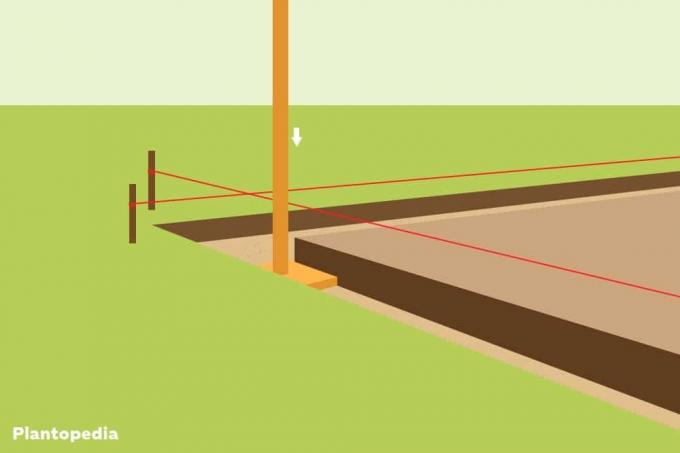
4. After compaction, place the stones one after the other on the foundation and knock them down with a hammer. After placing a stone, use the spirit level to check the incline and, if necessary, to correct the position of the stone. Repeat this step until the entire lawn edge is complete.
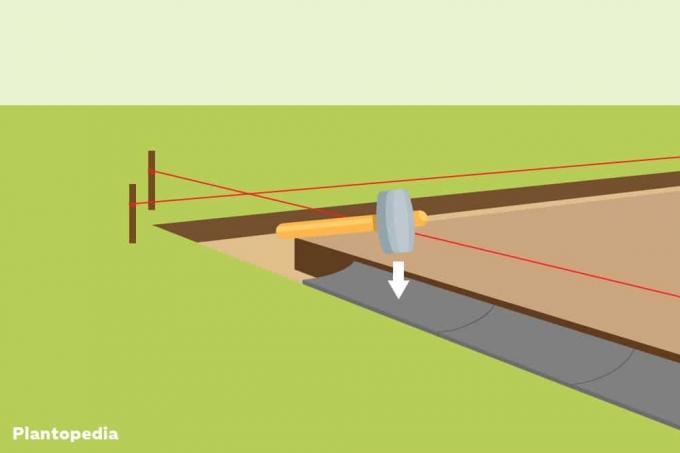
5. Alternatively, you can seal the gaps between the lawn edging stones with mortar at the end.
As you can see, setting lawn edging stones without concrete is possible and much easier. The only disadvantage with this variant is the possible displacement of the stones through the earth. For this reason, you should not use this variant on slopes, as the earth would simply be too heavy for the loose foundation.
tip: If you want to enable an even better demarcation, you should excavate two parallel pits and lay the stones there offset to the interfaces. That way, the grasses can't crawl through the cracks and still get away spread.



